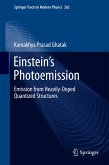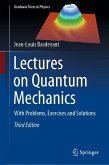This second edition includes an additional 62 new problems as well as expanded sectionson relativistic quantum fields and applications of quantum electrodynamics. Other special features include an introduction to Lagrangian field theory and an integrated discussion of transition amplitudes with discrete or continuous initial or final states. Once students have acquired an understanding of basic quantum mechanics and classical field theory, canonical field quantization is easy. Furthermore, the integrated discussion of transition amplitudes naturally leads to the notions of transition probabilities, decay rates, absorption cross sections and scattering cross sections, which are important for all experimental techniques that use photon probes.
Dieser Download kann aus rechtlichen Gründen nur mit Rechnungsadresse in A, B, BG, CY, CZ, D, DK, EW, E, FIN, F, GR, HR, H, IRL, I, LT, L, LR, M, NL, PL, P, R, S, SLO, SK ausgeliefert werden.
"Book goes through quantum mechanics starting from its foundations, that are introduced along the historical development. It also includes recent topics ... that is necessary to understand quantum effects inside chemistry, material science, microelectronics and photonics. The style is always very didactic, mathematical tools are introduced in a very gradual way ... . Some chapters may constitute an initial course in quantum mechanics, the others cover a graduate course in advanced quantum mechanics and can also provide a very useful introduction to quantum field theory." (Bassano Vacchini, Zentralblatt MATH, Vol. 1247, 2012)









